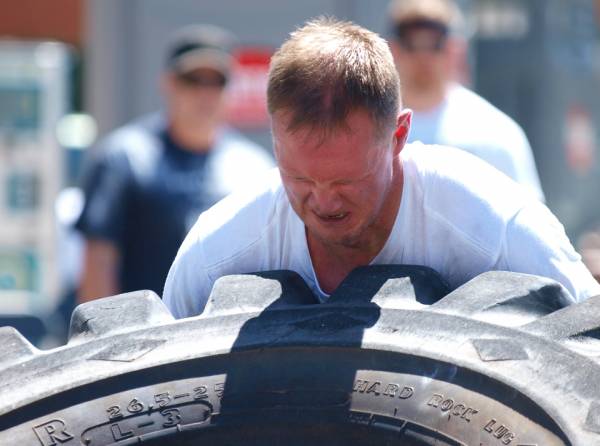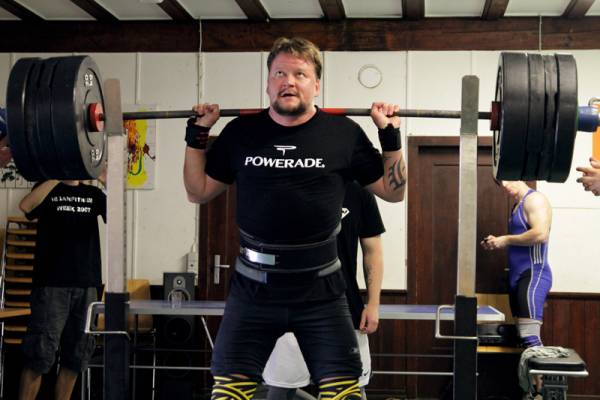It took twelve months of hard work and sacrifice to get to England’s Strongest Man. Just twenty seconds into the first event something went clunk in my back. The pain was staggering, and I was told my competition could be over.
Unfortunately, this is nothing new to me. I have dealt with countless fractures, tears, compressions, and sprains over the years. Some have been my own fault, others, out of my control.
Injuries are a part of sport, lifting, and training, but it doesn’t make the reality of having an injury any easier to comprehend or deal with. While picking up a few minor injuries can’t be avoided, more serious problems can be kept at bay. Here are the factors that have helped me learn from injuries and prevent recurrences over the years – to get back up again and stay standing for as long as possible.
After twelve months of hard work, my chances at England’s Strongest Man were dashed due to injury.
1. Understand Your Injury and Then Review What Went Wrong
First, understand what the injury is and how it was caused. Repetitive stress, poor movement patterns, imbalances, lifting something too heavy, or just a freak accident. Once you know the likely cause of what went wrong, then you can review why it happened. You are no longer spending hours in the weight room, so use your time off productively – think and assess.
Without a thorough review of the injury, the cause, and the effectiveness of the recovery plan, you will stand a greater chance of getting injured again. Reconsider the requirements of your sport or discipline. Are you preparing correctly in the weight room?
2. Examine Your Technique
Technique is king. You can succeed and fail on your lifting technique alone. This is obvious if you compete in powerlifting or strongman as it directly relates to sport-specific ability and kilograms lifted. However, if you play in another sport where you are transferring your time under a bar to performance on a pitch, in a pool, or on a running track, your lifting technique can still dictate success and successful injury prevention.
“If you are lifting with bad technique, then you are overloading some muscle groups, weakening others, and creating imbalances.”
As you lift, you ask your body to perform countless actions and contractions to build, support, and stabilize your muscles. If you are lifting with bad technique, then you are overloading some muscle groups, weakening others, and creating imbalances. All of these weaknesses are exposed when competing and so – apparently out of nowhere – something goes wrong.
Could your technique be creating an injury waiting to happen? If you’re not sure, find a coach who knows what he or she is talking about and focus on your fundamental training movements.

Lifting places huge demands on the body, so be sure you’re doing it right.
3. Programming Failing to Adequately Prepare You
Be careful you don’t neglect aspects of your training. Have you done enough specific and focused training for the task at hand or just hoped the body would stand up to the rigors of your challenge and sport?
“If you keep getting injured in competitions, then chances are you’re not preparing adequately.”
For example, my legs and back are strong enough for me to pick up a 420kg yoke and walk with it, but the supporting muscles need to be up to the task too. Are the quadratus lumborum and erector spinae trained and strong enough to cope with the challenge of the torsion the yoke places on the back? If they aren’t, you’re setting yourself up for an injury.
Don’t assume the body can handle what you’re throwing at it. Consider your training, and if this preparation is enough to adequately safeguard your body for the rigors of your sport. If you keep getting injured in competitions, then chances are you’re not preparing adequately.
4. Mobility and Flexibility
Both the general population and athletes are more aware of mobility and flexibility than ever. Pay attention to your joints, their range of movement, and your muscles’ ability to perform the movements they are being asked to do.
“Consider the areas that feel tight, jammed up, and not operating through a full range, and get them sorted.”
Mobility and flexibility work can easily be thrown into warm ups and recovery sessions. Without them, the joints are often not capable of loading the amount of stress being asked of them and something then has to give.
Don’t allow poor hip mobility to lead to a glute or hip flexor tear. Don’t allow poor hamstring flexibility to contribute to a hamstring pull on the day. Consider the areas that feel tight, jammed up, and not operating through a full range, and get them sorted.
Prevention is easier than cure. This is why movement patterns and mobility are top priority in my five step approach to programming:
- Fix the movement
- Clean up the rep
- Apply effort and intensity
- Get results
- Repeat
Walking around with joint soreness all day, every day is not the norm or acceptable. Nor is it a badge of honor. So if that’s you, sort it out now before you’re walking around all day, every day with crutches in your hands instead.

What good is lifting a lot of weight if you can barely walk for the rest of the day?
5. Physical Therapy Screenings
Don’t always try to self-diagnose. A trained eye is better than your observational powers, so find a good physical therapist or sports therapist and get your posture, movement, and proprioception checked by someone who knows exactly what they are doing.
They can find imbalances, problems, and potential weaknesses and give you a protocol to follow to ensure these ticking time bombs are ironed out. Poor posture and stability can lead to a whole range of pulls, tears, and pain. If you’re sat down all day, or you already feel like you’re hunched over, get yourself looked at.
Prevention Is Key
Remember – prevention is easier than the cure. Take the time to consider if your preparation is setting you up for success or injury. Improve on the quality of your training time and stay on the field of battle longer than your competitors.
You’ll Also Enjoy:
- 4 Needless Mistakes You’re Making in Strongman Training
- 3 Reasons You Don’t Squat More (And What to Do About It)
- Injury Prevention: The Most Important Goal in Every Training Session
- New on Breaking Muscle Today
Photo 1 courtesy of John Clark.
Photo 2 by By Calgary Reviews from Calgary, Canada (Sun and Salsa Festival Strongman Tire Flip), via Wikimedia Commons.
Photo 3 by By Celia Wagner, via Wikimedia Commons.






